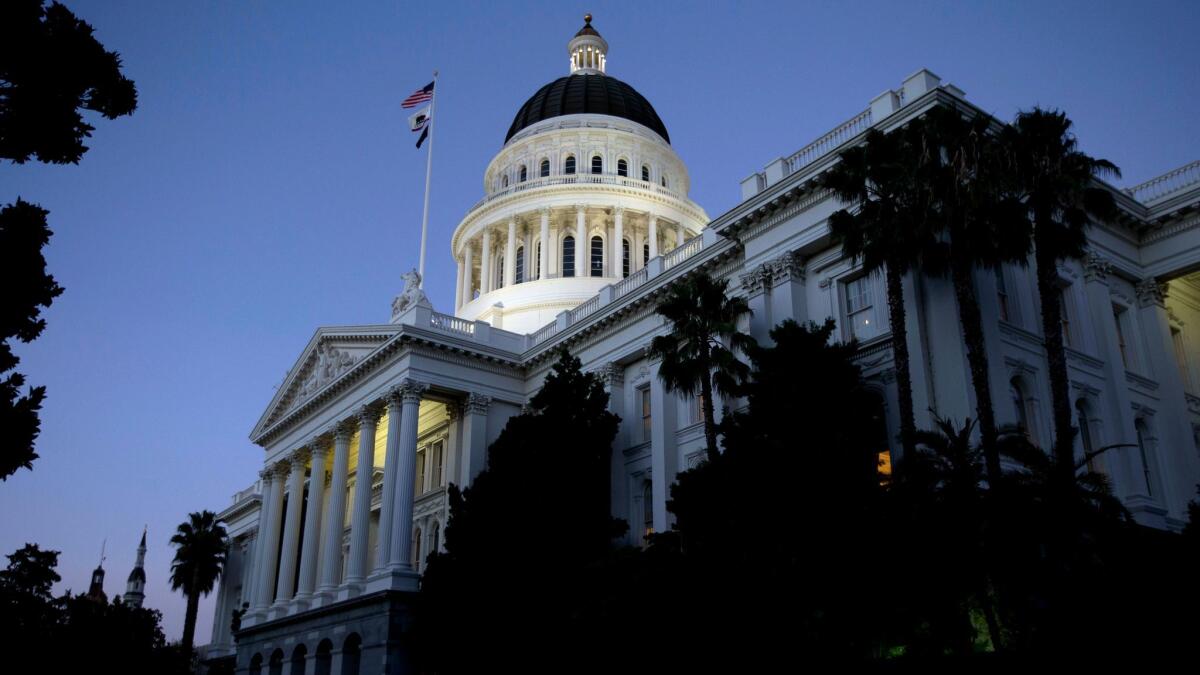Op-Ed: Why on Earth do California lawmakers compress a year’s worth of bills into five days?

- Share via
Let’s salute the hardy reporters who spent the week camped out at the state Capitol for the annual end of the legislative session, serving as the only conduit between 39 million Californians and their legislators. According to The Times’ John Myers, on Monday there were 623 pieces of legislation on the calendar, all of which reached some resolution by the Sept. 15 deadline for bills to advance out of both chambers. Those five days, punctuated by rapid-fire hearings and all-night floor sessions, represent the culmination of a year’s worth of work.
Why in God’s name does the state do things this way?
It makes sense to have a deadline to pass an annual budget; spending targets need to be renewed every year. It makes no sense to have rigid, artificial bottlenecks that lead to lawmakers sorting through 120 bills a day in the final week. Monumental decisions affecting the future of millions are given about as much time as a Taylor Swift song.
I’ve been asking people in the know about this for years, and the best explanation I’ve heard is that “it’s just always been done that way.” But I’ll go with the more likely one: The system makes it nearly impossible for either constituents or for lawmakers themselves to know what’s going on. This confusion enables legislative leaders to consolidate power and special interests to thrive. And we shouldn’t stand for it.
Most voters are blissfully unaware that the laws they abide by are mostly passed in all-nighter sessions once a year.
According to California’s legislative calendar, bills must pass out of initial committees in April and May, out of the house of origin by June 2, out of committees in the other chamber by July, and be completed by Sept. 15. Theoretically, nothing has to wait until the deadline; important legislation this year funding infrastructure improvements and extending the cap-and-trade program became law well before September. But in reality, most bills don’t see action until that final whirlwind.
You know there’s something really off about this, because the Legislature always takes a four-week recess in August, just before the mad scramble to finalize bills, and a 3½-month break after the deadline. That’s over one-third of the calendar that could be put to use. In other words, there’s no need to treat legislation in the nation’s largest state the way I treated all my term papers in college.
You have to conclude that somebody wants this setup to continue.
Maybe it’s the lobbyists, famously known as Sacramento’s “third house,” who line the hallways collecting political intelligence and twisting the arms of key lawmakers. Dragging out legislation until the final days makes it easier for special interests to kill what they don’t like and sneak through what they do.
Maybe it’s every lawmaker who doesn’t want activists to focus a pressure campaign against them. It’s impossible to keep track of what’s happening in the chaos of the final week. The schedule for hearings and floor votes is so haphazard that lawmakers need printed files to stay informed. Sessions routinely last long into the night, and surprise votes are common. Big issues like housing, immigration, healthcare and the environment all face simultaneous reckonings, making it hard to hammer in on one message.
And maybe it’s the legislative leadership, which uses this high drama to maximum advantage by keeping everyone off balance. Because only the Senate president and Assembly speaker truly know what will be voted on and when, they can play lawmakers off one another, horse trade behind the scenes, and make sure their donors are as happy as their caucuses.
Individual lawmakers can also show muscle. They perpetually engage in what’s known as hostage taking, refusing to vote for a colleague’s legislation unless their bills pass.
One particularly egregious example this year came from Assemblyman Chris Holden (D-Pasadena), chairman of the Utilities and Energy Committee, who tried to force through a complete overhaul of the state’s electricity market in the final week, without hearings or public scrutiny. In order to get leverage for his two bills, which would have regionalized the energy grid, returned Enron-style electricity trading to California and blocked community solar arrangements, Holden wouldn’t let SB 100, a bill that would require 100% of California’s electricity to come from renewable sources by 2045, out of his committee.
By Wednesday, Holden had backed down, but still would not give SB 100 a committee hearing, claiming it lacked support to pass, which clean-energy advocates dispute. Clearly, pairing a renewable-energy bill advocates desperately want with a regional grid proposal they oppose served Holden’s needs — and the major utilities as well.
Californians know intuitively that this is no way to run a railroad. Last year, voters demanded 72 hours of public notice online of all legislation before anything gets a final vote. That measure, Proposition 54, passed with more than 65% support, and moved the effective deadline for last-minute amendments from the last Friday of the session to the last Tuesday. It has muted some dead-of-night tactics, like amending a bill minutes before passage. But nobody in Sacramento took the hint that the public wanted a little more input.
That’s because lawmakers like the status quo. It provides a shroud for them and special interests to conduct the sausage-making of politics without pesky interference from the people they represent.
Most voters are blissfully unaware that the laws they abide by are mostly passed in all-nighter sessions once a year. But if they were, they would probably question the terrible design of our political structure, and wonder whom it serves.
David Dayen contributes to the Nation, the Intercept and the New Republic.
Follow the Opinion section on Twitter @latimesopinion or Facebook
More to Read
A cure for the common opinion
Get thought-provoking perspectives with our weekly newsletter.
You may occasionally receive promotional content from the Los Angeles Times.






